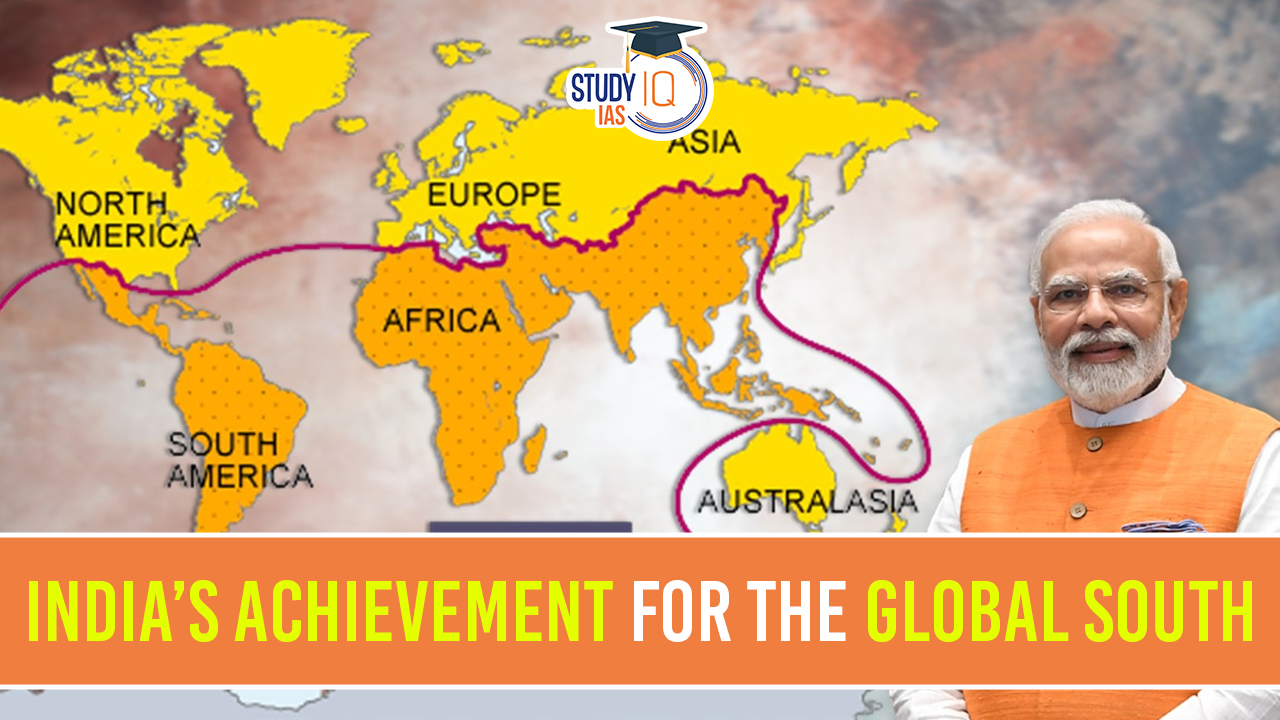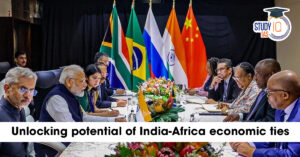Table of Contents
Context: India’s G20 presidency has achieved several significant outcomes for the Global South, reflecting its commitment to addressing the unique challenges faced by the developing countries.
Understanding the term “Global South”:
- The term “Global South” refers to countries that are often described as ‘developing’, ‘less developed’, or ‘underdeveloped’.
- It encompasses countries in Africa, Asia, and Latin America, which are characterised by higher levels of poverty, income inequality, and harsh living conditions compared to the “Global North”.
- ‘Global North’ refers to the developed countries like the US, Canada, Europe, Russia, Australia and New Zealand.
Origin and Characteristics:
Origin of the Concept of Global South
- The term Global South was first used in 1969 by political activist Carl Oglesby, who argued that the war in Vietnam was the culmination of a history of northern “dominance over the global south.”
- However, it was only after the disintegration of the Soviet Union in 1991, which marked the end of the so-called “Second World”, that the term “global south” gained momentum.
- The three-world analogy was first coined by a French demographer Alfred Sauvy in 1952.
- First World: Referred to the advanced capitalist nations;
- Second World: Referred to the socialist nations led by the Soviet Union; and
- Third World: Referred to developing nations, many at the time still under colonial influence.

- With the fall of the Soviet Union, which marked the end of ‘Second World’ — resulted in the decline of the usage of the term ‘Third World’ too.
- Additionally, criticisms arose regarding the negative connotations associated with the term “Third World,” which often portrayed developing nations as impoverished, unstable, and underdeveloped.
- To address these concerns and provide a more neutral and inclusive terminology, the term “Global South” emerged.
- The Brandt Line is a visual representation of the division between the Global North and the Global South based on economic disparities.
- It was proposed by the German statesman Willy Brandt in the 1980s and gained significant attention.
Characteristics of the Global South:
- Geopolitical, not geographical: The term ‘Global South’ is geopolitical and not geographical. In fact, the Global South’s two largest countries- China and India lie entirely in the Northern Hemisphere. Therefore, its usage denotes a mix of political, geopolitical and economic commonalities between nations.
- Colonial legacy: Countries in the Global South were mostly colonies and were at the receiving end of imperialism. Eg: African countries.
- Economic challenges: Many Global South countries face economic disparities, poverty, and a lack of infrastructure etc.
- Non-alignment and diverse alliances: Due to their historical experiences and the imbalanced relationships with the Global North, countries in the Global South often prefer not to align themselves strongly with any single global power. They may form alliances or pursue independent foreign policies based on their own interests.
Significance of the Global South
- Resource rich: ‘Global South’ is significant because of its large population, rich cultures, and abundant natural resources.
- Growing Economic Might: The economic prowess of the Global South has been increasing rapidly.
- By 2030 it is projected that three of the four largest economies will be from the Global South, with the order being China, India, the U.S. and Indonesia.
- Already the GDP in terms of purchasing power of the Global South-dominated BRICS nations — Brazil, Russia, India, China and South Africa — surpasses that of the Global North’s G-7 club. And there are currently more billionaires in Beijing than in New York City.
- Increasing Political Visibility: This economic shift has gone hand in hand with enhanced political visibility.
- Countries in the Global South are increasingly asserting themselves on the global scene be it China’s brokering of Iran and Saudi Arabia’s peace deal or Brazil’s attempt to push a peace plan to end the war in Ukraine.
India as the Voice of Global South
- Historical Perspective: India’s own history of colonialism and struggle for independence has given it a deep understanding of the challenges faced by countries in the Global South.
- Economic Growth and Development: As one of the fastest-growing major economies, India’s success story can serve as an inspiration for other developing countries.
- Multilateral Engagement: India is an active participant in various international forums, including the United Nations, G20, BRICS, and IBSA, where it can articulate the concerns and priorities of the Global South.
- India hosted and presided over the G20 Leaders’ Summit 2023 for the first time in history.
- South-South Cooperation: India has been a strong proponent of South-South cooperation, emphasising the importance of collaboration and mutual assistance among developing countries.
- Bridge between North and South: India’s foreign policy objective of bridging the gap between the Global North and the Global South positions showcases it as a potential mediator and facilitator..
India’s achievement and significant outcomes for the Global South: G20
India’s G20 presidency has achieved several significant outcomes for the Global South which include:
- Inclusion of the African Union:
- India’s support for the inclusion of the African Union in the G20 process demonstrates its longstanding commitment to forging strong links with developing countries.
- This move acknowledges the structural and institutional challenges that low-income countries face in the current international order.
- Climate Finance and Development:
-
- India emphasised on climate finance and debt relief in the G20 declaration to address the economic challenges faced by developing nations.
- The developed countries promised to provide $100 billion in climate finance which is crucial for developing countries as they seek to adapt to the impacts of climate change.
- Additionally, India’s efforts to reorient the World Bank’s agenda toward climate-centric projects show its dedication to sustainable development and decarbonization.
- Infrastructure and Connectivity Initiatives:
- The launch of the India-Middle East-Europe Economic Corridor and the Global Biofuels Alliance demonstrates India’s commitment to connect various partners for mutual benefit.
- These initiatives aim to drive decarbonization, promote connectivity, and create infrastructural opportunities for firms in developing countries.
- The economic corridor project, in particular, can be seen as a response to China’s Belt and Road Initiative (BRI), emphasising India’s role in shaping regional development initiatives.
- Mainstreaming Development Concerns:
- India used its G20 presidency to mainstream development concerns, treating them as central rather than ancillary issues.
- This approach encourages specific actors, such as the US, UAE, EU, and Saudi Arabia, to collaborate and pool their capabilities for side initiatives that address development challenges.
Initiatives for the South-South Cooperation
- BRICS Forum: BRICS is an association of five major emerging economies that includes Brazil, Russia, India, China, and South Africa. The forum promotes economic cooperation, political dialogue, and mutual support among its member countries.
- India, Brazil, and South Africa (IBSA) Forum: It aims to promote cooperation in various areas, including agriculture, trade, investment, science and technology, education, and social development.
- Group of 77 (G77): The G77 is a coalition of developing countries at the United Nations. The group promotes the interests and priorities of its member countries, particularly those in the Global South.
- International Day for South-South Cooperation: The United Nations observes the International Day for South-South Cooperation on September 12th each year. It commemorates the adoption of a plan of action by the United Nations General Assembly in 1978 to promote technical cooperation among developing countries.


 Micrometeoroids: Tiny Space Particles, M...
Micrometeoroids: Tiny Space Particles, M...
 India Needs a National Insolvency Tribun...
India Needs a National Insolvency Tribun...
 Unlocking the Potential of India–Afric...
Unlocking the Potential of India–Afric...

























